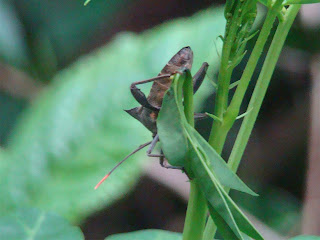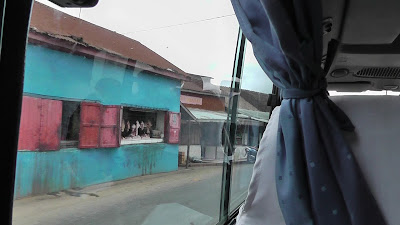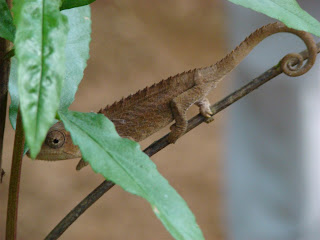Giraffe-Necked Weevil at Perinet
Some Bug in Perinet
Green Pill Millipede at Mantadia
Leaf Bugs at Ampijoroa (Each of those pieces of white lint is actually a bug about the size of the top of your pinkie. They have tiny little black legs, and when they move they look like they're flowing along rather than walking. The white fluff keeps them safe--any bird going after them would just get a mouthful of fluff.)
Shield Bug at Ampiroroa
Butterfly at Ranamafano
Orange and Black Tree Beetles (Each of those things that look like candy or an odd rock is a little bug. Like the leaf bugs, they seem to flow rather than walk.)
Rainbow Bush Locust at Isalo (This thing is about three inches long and impressive. Truly odd and kinda gorgeous in a tacky way.)
Green Lynx Spider at Berenty
Handsome Beetle at Berenty
Ants That Ate a Snake at Berenty
Madagascar Hissing Cockroach at Berenty (Andrea saw one hiss!)
This is the story of Wendy and Andrea's intermittently excellent adventure in Madagascar in October of 2011. These posts are based on a journal that Wendy kept during the trip. Madagascar is the fourth largest island in the world. It is the home of eighteen ethnic groups, some 80 species of lemurs, and over 200 species of birds. It has rain forests, deciduous forests, spiny forests, mountains, and coastal plains. It does not have traffic lights, skyscrapers, Starbucks, or much money.
Wednesday, December 21, 2011
Saturday, December 10, 2011
Day 6: October 11, 2011
Sitting in the Tana airport. Got caught in a mad traffic jam and had only 15 minutes for lunch—three courses, jammed down. Not fun.
The ride here was fascinating. People mostly wore Western clothing, and many were barefoot. Lots of people walking, some on bikes, lots of cars, lots of people with bundles on their heads (mostly women). Towns with shacks and stalls jammed together.
We stopped for gas and I went into the shop, which had a fairly wide selection but only a few of each item. Lotsa empty space on the shelves. Much of what they sell is familiar—M&Ms, KitKat bars. Little in that particular shop seems particularly Malagasy or African. I bought toothpaste. I’ll be curious to see what it’s like. [That toothpaste, a brand I had never heard of, was kind of gross, thick and chalky. I later got Colgate, which was pretty much what Colgate is in the US.]
In the more rural areas, people have more space but seem poorer. Shacks, mud homes, few more than one room. Painstaking scratching out of livings. The towns and Tana bustle, with shops cheek by jowl and little in the way of sidewalks. There are phone-recharging booths, lottery merchants, little “groceries” with little by the way of groceries. At one point we saw some selling clothing hung off a stone/cement wall—not like a yard sale or flea market, but like that was his shop.
In rural areas, we frequently saw women washing clothing in rivers, lakes, streams where the water was often far from clean. They drying the clothing by laying the items down on rocks or on the grass. In towns and Tana, clothing is hung from clotheslines on dozens of balconies.
Many of the rural areas have electricity, and some people have what look like TV antennas. Here and there, generally but not always close to towns, are signs of wealth—actual constructed homes with actual roofs and paint and design elements. And many rooms. While the poor house are often right near the road, these are further back, and often on hills—and often gated.
In Tana we passed an actual department store with big signs announcing what it sells, all in French. [The official languages are Malagasy and French. Recently English has been made official, but it’s by the least frequently used.]
About an hour and a half later: Sitting on the beach in Mahajunga, at the Zahamotel. It’s rather stunning. Only a handful of people on the beach: a blonde tourist baking in the sun, two gorgeous African men lying in the shade wearing only white shorts, an African man with a reflective orange-yello vest (taking a break from work, I assume), and in the distance a small family.
I just moved to a table in front of our room in the shade. When I pulled out the chair to sit on, there was a lovely light-green gecko on it. It stayed for a while and then darted away.
They let me use the office computer at the motel, which has a French keyboard (known as AZERTY versus our QWERTY). It took me forever to get onto Gmail, and all the error messages were in French. I can read some French, but not enough to be helpful in this case.
I knew that my username was coming out okay, because I could see it, but of course I couldn’t see how my password was coming out. So I finally had the bright idea to type my password into the username slot, just to see exactly what I was typing. And what I thought was the number 5 was coming out as close parens. You have to press shift to get the number 5, as though it’s a capital. Who knew?
Everything was slow, slow, slow, and I felt bad about using the guy’s computer for so long. And the keyboard made me crazy—there were enough letters in the same places I was used to, so I would start typing quickly but then stumble on misplaced As and Ms.
About the weather on the trip so far: it’s mostly been mild and even chilly. It’s rained frequently, though never for long. I saw a rainbow over the lagoon at Vakona. Here, though—across the country and closer to the equator—it has been very hot at times. But the breeze off the ocean is lovely.
Bedtime: Talk about being out of one’s comfort zone. I just went to the bathroom and showered in a room in which I had just seen a GIANT cockroach. No romantic Madagascar hissing cockroach, either. Just a plain, old-fashioned, disgusting, scurrying roach/water bug/palmetto bug. It ran to the wall, and I sure hope it found its way out!
Monday, December 5, 2011
Day 5: October 10, 2011
Didn’t go to Mantadia National Park today with the group, which is sad. It may mean that I don’t get to see diademed sifakas. But it’s one and a half hours each way by bus and includes steep, slippery slopes, and I am sore. I want to keep my feet up, ice my knees, and let my body un-shock itself from yesterday's fall. I had weird leg cramps last night, and I’m still a little freaked out.
[I was able to go to Mantadia at the end of the trip and saw many diademeds, so it worked out okay. I also saw them at Lemur Island, also toward the end of the trip. I took this photo there.]
It’s not shabby spending the day at the lodge. I’m sitting on the porch and it’s a gorgeous mild spring day (in October!), and I’ve got a lovely view. There is a bottlebrush tree right in front of me, and birds keep stopping by.
I may be the only guest at the lodge not out and about and having adventures. I can hear noises of people maintaining the place—cleaning, trimming trees, moving tables in the restaurant.
I could not begin to imagine the lives of the people who work here. Well, maybe I could begin to, but not much past that. The people who work here are well-off, I guess, by Malagasy standards, just by having jobs. Ninety percent of people in Madagascar live on less that $2/day (and many a lot less than that), and I believe that's what $2 would buy in the US, not here.
We have passed so much poverty on our drives. We saw one man clearing a rice paddy patch. He was up to his waist in water, and he was carrying mud out of the main area (maybe 20 feet by 40 feet) and making a wall of it around the perimeter. And he was doing this handful by persistent handful. Gather the mud here, carry it there. Gather the mud here, carry it there. Gather the mud here, carry it there. A million times. Sisyphus had nothing on him!
What a difference an accident of birth makes. I travel, see shows, have a nice home, eat well, and generally have a comfortable standard of living. Yes, I’ve worked hard—but not as hard as the guy in the rice paddy!
I wonder how many gay people there are in Madagascar. Math would suggest that there are hundreds of thousands, possibly millions. How many get to love who they want to love? How do they find each other? How dangerous are their lives?
Yes, I was very lucky to be born when and where I was.
[I was able to go to Mantadia at the end of the trip and saw many diademeds, so it worked out okay. I also saw them at Lemur Island, also toward the end of the trip. I took this photo there.]
Diademed Sifaka at Lemur Island, Madagascar
It’s not shabby spending the day at the lodge. I’m sitting on the porch and it’s a gorgeous mild spring day (in October!), and I’ve got a lovely view. There is a bottlebrush tree right in front of me, and birds keep stopping by.
Vakona Lodge
The first part is early afternoon with a light rain;
the second is just before dinner.
the second is just before dinner.
I may be the only guest at the lodge not out and about and having adventures. I can hear noises of people maintaining the place—cleaning, trimming trees, moving tables in the restaurant.
I could not begin to imagine the lives of the people who work here. Well, maybe I could begin to, but not much past that. The people who work here are well-off, I guess, by Malagasy standards, just by having jobs. Ninety percent of people in Madagascar live on less that $2/day (and many a lot less than that), and I believe that's what $2 would buy in the US, not here.
We have passed so much poverty on our drives. We saw one man clearing a rice paddy patch. He was up to his waist in water, and he was carrying mud out of the main area (maybe 20 feet by 40 feet) and making a wall of it around the perimeter. And he was doing this handful by persistent handful. Gather the mud here, carry it there. Gather the mud here, carry it there. Gather the mud here, carry it there. A million times. Sisyphus had nothing on him!
What a difference an accident of birth makes. I travel, see shows, have a nice home, eat well, and generally have a comfortable standard of living. Yes, I’ve worked hard—but not as hard as the guy in the rice paddy!
I wonder how many gay people there are in Madagascar. Math would suggest that there are hundreds of thousands, possibly millions. How many get to love who they want to love? How do they find each other? How dangerous are their lives?
Yes, I was very lucky to be born when and where I was.
Sunday, December 4, 2011
Andrea's Reptile Photos
Parson's chameleon at Perinet Reserve.
Tree boa at Perinet Reserve
For some reason, Madagascar tree boas are rarely found in trees. I guess no one told them their name.
Will's chamelon at Perinet Reserve.
 Nile crocodile at Ampijoroa. This isn't behind a fence. Andrea was in a small boat, not at all far away, when she took this picture.
Nile crocodile at Ampijoroa. This isn't behind a fence. Andrea was in a small boat, not at all far away, when she took this picture.
Subscribe to:
Posts (Atom)
































